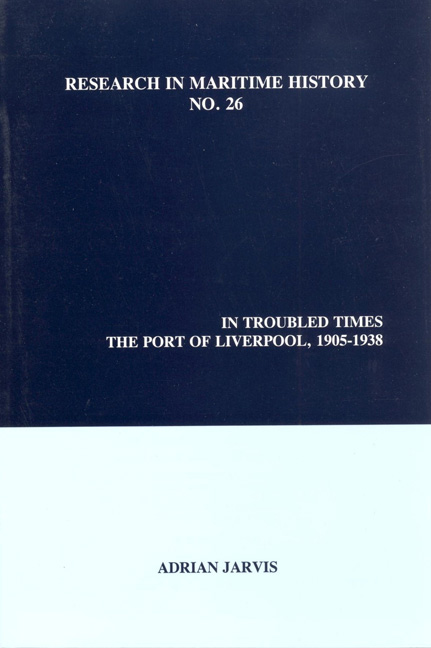Book contents
- Frontmatter
- Table of Contents
- List of Figures
- Foreword and Acknowledgements
- Conversion Factors for Imperial Measurements
- Introduction: The Port of Liverpool in 1905
- Chapter 1 The Port and Its Trade in 1905
- Chapter 2 Gladstone Dock
- Chapter 3 Not Before Time: The Board Keeps its Promise
- Chapter 4 Engineering, Management and Decision-making
- Chapter 5 Making the Customers Happy
- Chapter 6 Sand, Silt and Sewage: The Work of the Board's Dredgers
- Chapter 7 The Provision of Specialist Cargo Facilities
- Chapter 8 Into the Modern World?
- Conclusion: On the Eve of War
- Appendix: Port Efficiency: A Short Methodological Discourse
- A Note on Sources: Abbreviations
- Bibliography
- Index
Chapter 3 - Not Before Time: The Board Keeps its Promise
- Frontmatter
- Table of Contents
- List of Figures
- Foreword and Acknowledgements
- Conversion Factors for Imperial Measurements
- Introduction: The Port of Liverpool in 1905
- Chapter 1 The Port and Its Trade in 1905
- Chapter 2 Gladstone Dock
- Chapter 3 Not Before Time: The Board Keeps its Promise
- Chapter 4 Engineering, Management and Decision-making
- Chapter 5 Making the Customers Happy
- Chapter 6 Sand, Silt and Sewage: The Work of the Board's Dredgers
- Chapter 7 The Provision of Specialist Cargo Facilities
- Chapter 8 Into the Modern World?
- Conclusion: On the Eve of War
- Appendix: Port Efficiency: A Short Methodological Discourse
- A Note on Sources: Abbreviations
- Bibliography
- Index
Summary
Thus far, the concern has been with the handling of large and/or exceptional ships, with the need to make large investments to keep up both with the growth of these vessels and with the ever-increasing quantities of goods they sought to discharge and to load with ever-faster turnaround. But these were not the only ships to use the port, and we must now turn our attention to the provision of facilities for more humble craft.
In the earliest days of the Dock Estate, docks were built for the “big” ships, and the coastwise trade was left more or less to chance. The first dock to change that was Clarence, opened in 1830 specifically for steamers, which at that date were all in the coastwise or short-sea trades, and it was followed by a handful of other docks designed for coasters, of which Collingwood (opened 1848) was the last. After that, coasters had to survive as their ancestors had, on facilities handed down as outgrown by the trades using larger vessels. The allocation of a dock to the use of coasters thus came to be a matter not of what it was suitable for but rather of whether it was suitable for anything better. This repeatedly emerges in discussions at the Board and in print:
some of the Port Authorities have treated the coastwise trade as the Cinderella of the transport world, and the failure to meet its requirements, and especially its relegation to the outworn and obsolete sections of their undertakings has added enormously to its handicap in the competition with railway transport.
This only meant, however, that accommodation for the coasters would probably, although not necessarily, be unsuitable. Nelson Dock, for example, was handed down to the larger class of “Irish Boat” and proved extremely satisfactory. It had been built for the North Atlantic trade, opened in 1848, but it was sufficiently deep and spacious for the largest coasters of the early 1900s, had reasonably wide quay margins and was connected to the railways. But Nelson was a happy example: many of the other docks reserved for coasters were apparently unsuitable for almost anything. The prime example was the Clarence “system,” consisting of a wet, half-tide and two graving docks, as well as a graving dock basin with a graving grid.
- Type
- Chapter
- Information
- In Troubled TimesThe Port of Liverpool, 1905-1938, pp. 71 - 90Publisher: Liverpool University PressPrint publication year: 2003



